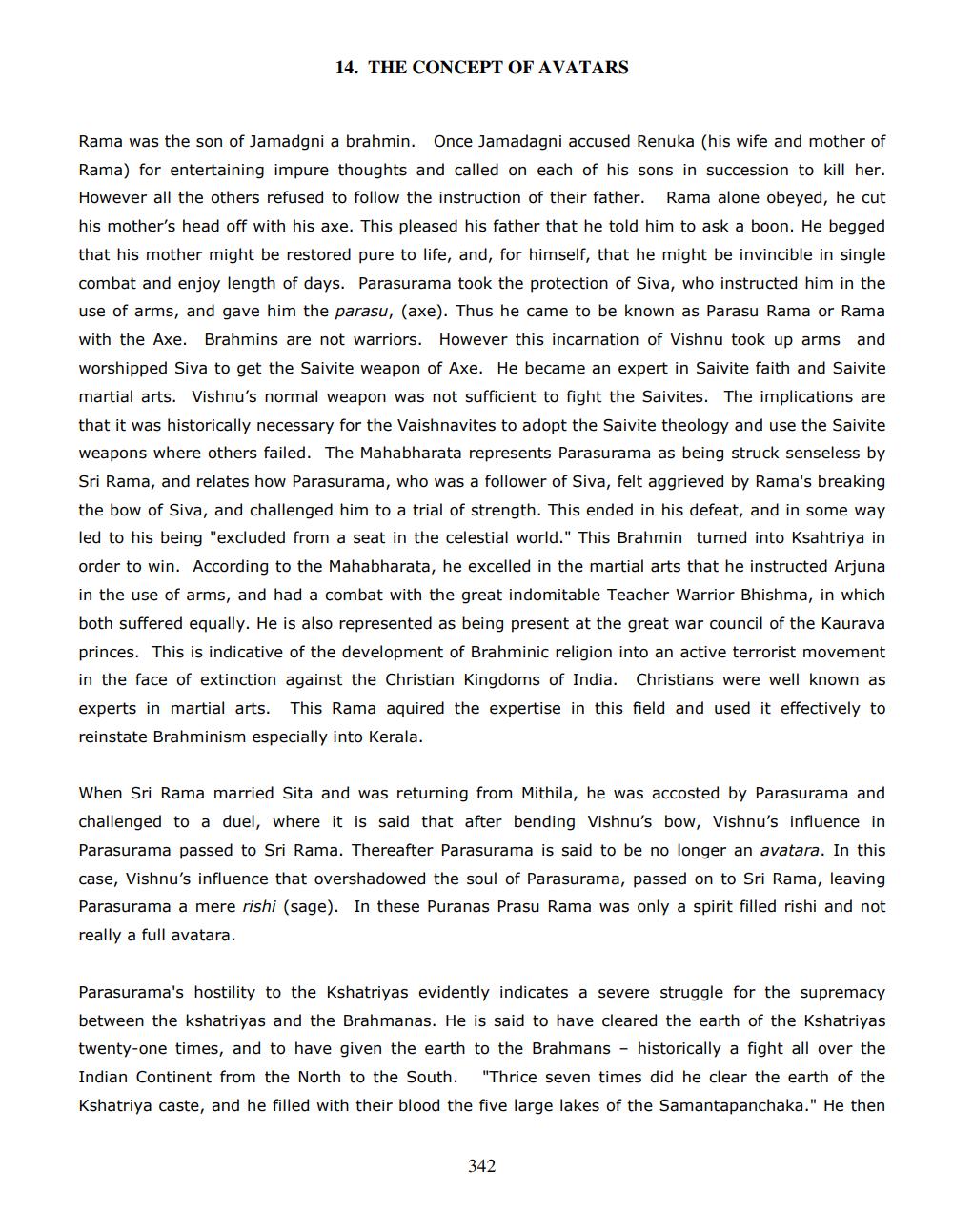________________
14. THE CONCEPT OF AVATARS
Rama was the son of Jamadgni a brahmin. Once Jamadagni accused Renuka (his wife and mother of Rama) for entertaining impure thoughts and called on each of his sons in succession to kill her. However all the others refused to follow the instruction of their father. Rama alone obeyed, he cut his mother's head off with his axe. This pleased his father that he told him to ask a boon. He begged that his mother might be restored pure to life, and, for himself, that he might be invincible in single combat and enjoy length of days. Parasurama took the protection of Siva, who instructed him in the use of arms, and gave him the parasu, (axe). Thus he came to be known as Parasu Rama or Rama with the Axe. Brahmins are not warriors. However this incarnation of Vishnu took up arms and worshipped Siva to get the Saivite weapon of Axe. He became an expert in Saivite faith and Saivite martial arts. Vishnu's normal weapon was not sufficient to fight the Saivites. The implications are that it was historically necessary for the Vaishnavites to adopt the Saivite theology and use the Saivite weapons where others failed. The Mahabharata represents Parasurama as being struck senseless by Sri Rama, and relates how Parasurama, who was a follower of Siva, felt aggrieved by Rama's breaking the bow of Siva, and challenged him to a trial of strength. This ended in his defeat, and in some way led to his being "excluded from a seat in the celestial world." This Brahmin turned into Ksahtriya in order to win. According to the Mahabharata, he excelled in the martial arts that he instructed Arjuna in the use of arms, and had a combat with the great indomitable Teacher Warrior Bhishma, in which both suffered equally. He is also represented as being present at the great war council of the Kaurava princes. This is indicative of the development of Brahminic religion into an active terrorist movement in the face of extinction against the Christian Kingdoms of India. Christians were well known as experts in martial arts. This Rama aquired the expertise in this field and used it effectively to reinstate Brahminism especially into Kerala.
When Sri Rama married Sita and was returning from Mithila, he was accosted by Parasurama and challenged to a duel, where it is said that after bending Vishnu's bow, Vishnu's influence in Parasurama passed to Sri Rama. Thereafter Parasurama is said to be no longer an avatara. In this case, Vishnu's influence that overshadowed the soul of Parasurama, passed on to Sri Rama, leaving Parasurama a mere rishi (sage). In these Puranas Prasu Rama was only a spirit filled rishi and not really a full avatara.
Parasurama's hostility to the Kshatriyas evidently indicates a severe struggle for the supremacy between the kshatriyas and the Brahmanas. He is said to have cleared the earth of the Kshatriyas twenty-one times, and to have given the earth to the Brahmans - historically a fight all over the Indian Continent from the North to the South. "Thrice seven times did he clear the earth of the Kshatriya caste, and he filled with their blood the five large lakes of the Samantapanchaka." He then
342




